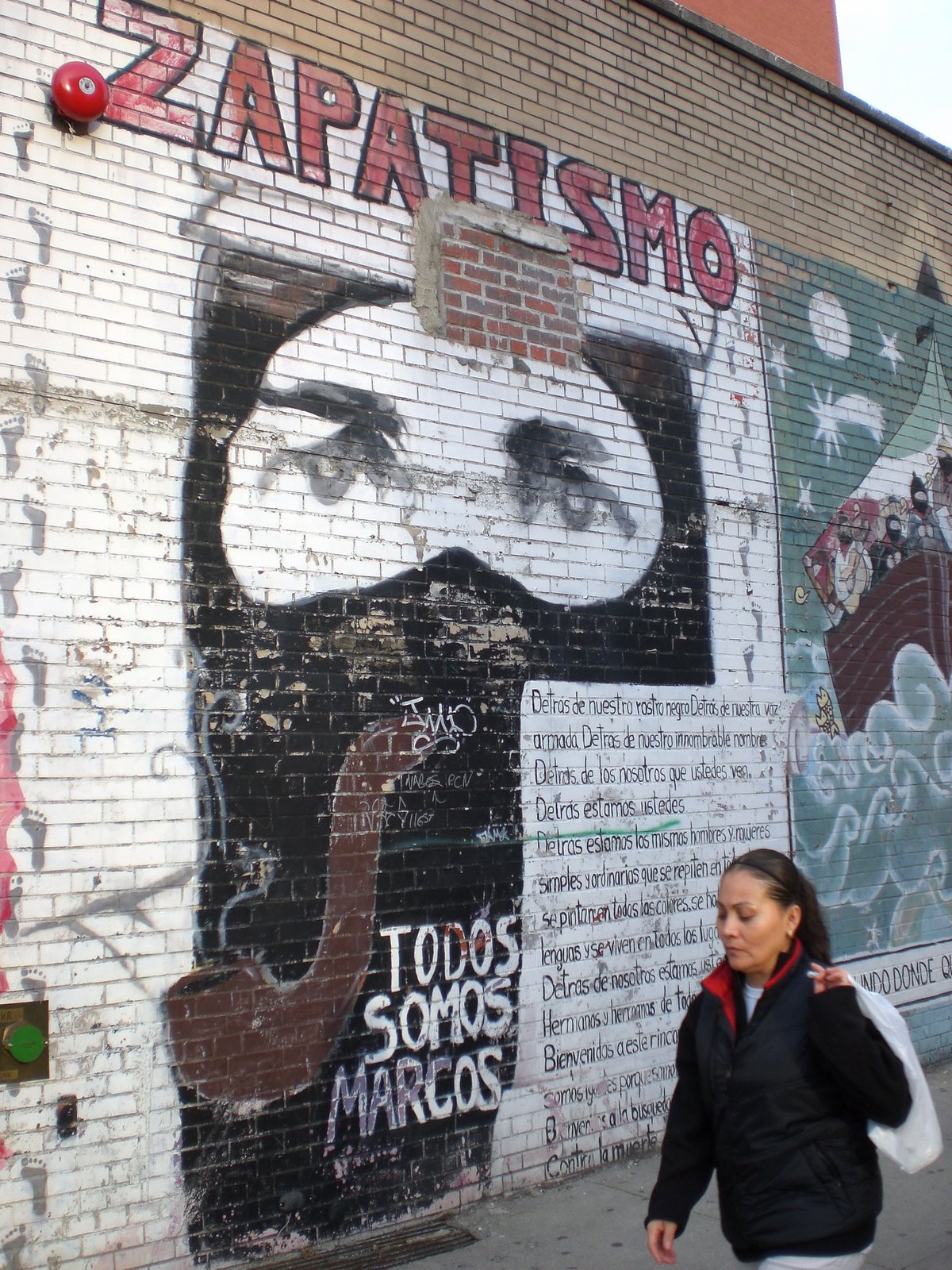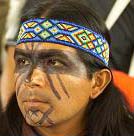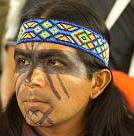
by Michael Eamonn Miller, NYC Pavement Pieces
Marcos in Manhattan” title=”Marcos in Manhattan” class=”image thumbnail” height=”100″ width=”75″>Marcos in Manhattan
The noisy, bustling streets of upper Manhattan known as “El Barrio” bear scant resemblance to the farmlands of Chiapas, Mexico’s poorest, southernmost state. But three decades of Mexican immigration to New York have subtly transformed the neighborhood, establishing ties between the two communities and injecting new, sometimes controversial, ideas into the fight against gentrification in El Barrio.
No group demonstrates these ties or this controversy as strikingly as Movement for Justice in El Barrio (MJB). Founded in December 2004 by tenants fighting eviction from their East Harlem apartment building, MJB now considers itself a “Zapatista” organization—a name normally reserved for armed revolutionaries fighting for their indigenous Mayan lands in Chiapas. But to the extent that the affiliation has brought new methods of grassroots democracy and community organization to East Harlem, MJB’s brand of Zapatismo holds promise for a neighborhood undergoing rapid gentrification.
Gentrification affects many of New York’s poorer neighborhoods, not just El Barrio. Loosely defined as an influx of money and development, gentrification causes the displacement of low-income families by wealthier ones, its critics argue. As New York crime rates have fallen over the past 15 years, parts of the city once shunned by young, wealthy professionals have become targets for development. In neighborhoods like El Barrio, where many poor families have only recently arrived in the US, the potential for rapid change—and displacement of the poor—is even greater. Across New York, rising rents have led to confrontations between landlords and tenant organizations, between the tenants’ need for affordable housing and the owners’ property rights. In this clash of philosophies, New Yorkers’ homes are at stake.
“Gentrification is a fact of life,” argues East Harlem landlord Scott Zwilling.
“People look at me and say ‘the big, bad owner kicked me out,'” Zwilling said. “But if it wasn’t me buying the property and raising the rent, there would have been 10 others ready to do the same thing.”
But gentrification is neither inevitable nor desirable, according to Movement for Justice in El Barrio.
“What initiated the organization was the housing crisis,” said MJB founder Juan Haro. Fearful of eviction, tenants in five East Harlem buildings approached Haro for help. “People were trying to figure out how to combat the effects of gentrification,” he said.
Since 2004, MJB has grown to more than 380 members in 25 buildings around El Barrio. One key to this growth has been MJB’s link to the Zapatistas—a connection that, while intuitive for some members, may surprise Americans who remember 1990s images of masked Zapatista peasants clutching rifles.
MJB’s embrace of Zapatismo began in summer 2005. Far from a publicity stunt, the move was “organic,” Haro said.
“What happened early on was we began an internal discussion to learn about different social movements based in the US and abroad,” explained Haro. “Zapatismo made sense because most of our members are Mexican.” One of the group’s first meetings coincided with the “Sixth Declaration of the Lacondan Jungle,” a Zapatista call for an international campaign against neoliberalism and repression. “Our members read the declaration and got very excited,” Haro said.
El Barrio has had a large Hispanic population since the 1950s. But today’s neighborhood reflects recent national immigration trends. Just as Hispanics are now the largest minority in the US—growing from 9 to 12.5 percent of the population from 1990 to 2000—they have risen from 32 to 55 percent of the population in El Barrio since 1970, according to US Census and city government statistics. Meanwhile, the makeup of Hispanics in El Barrio has also changed. While Puerto Rican flags can still be seen on neighborhood murals and in shop windows, El Barrio’s cultural and political movements increasingly reflect its growing Mexican population.
But MJB’s affiliation with the Zapatistas goes beyond mere cultural connections, instead relying upon the perception of a common enemy and a shared solution.
Like the Zapatistas in Chiapas, MJB sees neoliberalism—free trade and unregulated international businesses—as the underlying problem. In New York, MJB members argue, the gradual weakening of rent control laws fits this neoliberal pattern and has led to gentrification.
After MJB’s early campaigning against local landlord Steve Kessner, he sold all 47 of his buildings to a London-based investment bank, Dawnay, Day. It was an important but Pyrrhic victory for MJB. Unlike Kessner, “Dawnay, Day has from the outset been very explicit about what they are trying to do,” Haro said.
“It’s not our goal to kick people out of their homes,” said Michael Kessner, director of operations for Dawnay, Day in New York and a relative of former owner Steve Kessner. “But obviously we’re out to make a profit, too.”
“Movement for Justice is out to serve their own interests,” Kessner said, describing MJB as “very confrontational” and only representing a small percentage of Dawnay, Day’s tenants.
At the heart of the disagreement are Dawnay, Day’s business practices since buying the apartments in March.
Dawnay, Day has aggressively tried to replace tenants in rent-controlled apartments with those willing to pay higher amounts, Haro said. “Dawnay’s other new tactic is offering money to the tenants to vacate.” The company has introduced a “buy out program,” he said, in which longer-term tenants have been offered $10,000 to leave their apartments. “Because of rent control, they’re targeting longer term tenants, some of whom have lived in El Barrio for 30-40 years.”
A lawsuit filed in October by 17 MJB members accused Dawnay, Day of making “false, deceptive and misleading representations to [tenants] in verbal and written communications, including rent bills and other correspondence,” in an attempt to force them out of their apartments. If true, these charges would violate a number of New York consumer protection laws.
“Billing and accounting was an issue at first,” Kessner said, referring to rents allegedly owed to the previous owner. “I think [the lawsuit] has been resolved because we’ve credited their accounts.”
But neither the lawsuit against Dawnay, Day nor the broader fight against gentrification is over, according to MJB.
The influx of multinational companies such as Dawnay, Day is both “an international problem” and a consequence of neoliberalism, Haro said. “To combat this, we have to have an international plan. It can’t be local, can’t be regional: it has to be international.”
MJB’s response to both Kessner and Dawnay, Day has been to rely on Zapatista strategies of community consultation and cooperation. MJB’s “Consultas del Barrio” is a grassroots initiative for popular democracy within the neighborhood. MJB canvassed over 800 people—of all ages and races—from around the community, asking them to identify the issues that most affected their lives.
“Our goal is to create space and opportunity for the broader community to engage in the democratic process,” Haro said. “We can’t say we represent every single member of the community unless we consult with all of them.”
“People feel discouraged or disillusioned with the forms of discourse in civil society,” he said. “For example, when it comes to voting, they feel that the powerful always win out,” but the “consultas” represent another form of politics, independent from the government.
Though time-consuming, these “consultas” have allowed MJB to stay abreast of evolving relationships between El Barrio’s tenants and landlords—relationships which, in the case of Dawnay, Day, are volatile.
“We consider ourselves to be on ‘red alert’ because of what Dawnay, Day has been doing,” Haro said.
But an equally important side to MJB’s success has been its cooperation with other anti-gentrification and social justice groups, both in New York and around the world. On October 21, MJB hosted its first “NYC Encuentro for Humanity and Against Gentrification.”
“The encuentro is a tool very helpful in getting people from different communities to share stories that are usually left out or silenced,” said Helena Wong, coordinator for the Chinatown Justice Project and for Right to the City New York. Attending the “encuentro” made sense, she said, because MJB and Right to the City both face gentrification in their respective communities.
“Gentrification is something that’s been happening in Chinatown for 10 years,” she said, “but you don’t know it’s happening until storefronts start changing.” Companies are buying up entire blocks, “kicking people out” so that they can build luxury condos, she said. Wong sees the same erosion of New York’s once-strong rent protection laws at work in Chinatown as in El Barrio.
“It seems like our struggles are the same, the causes of the conditions in our communities are the same,” Wong said. “We’re never going to win anything by ourselves in Chinatown so it’s important to work with other communities that are marginalized.”
Although tenant groups like Right to the City and MJB see gentrification as the enemy, landlords consider it their livelihood.
According to Zwilling, gentrification is as old as the neighborhoods themselves. It isn’t just business, he argues, it’s part and parcel of the American promise of upward mobility.
Zwilling says he understands peoples’ anger towards landlords, and has offered to help former tenants find new apartments. But landlords aren’t to blame for gentrification, he argues.
“Whose fault is it? I have a family to feed, too,” Zwilling said. “Is it the former owner’s fault? Is it no one’s fault? Is it the city’s fault for not having programs in place to help these people?”
The gentrification of East Harlem isn’t likely to slow down any time soon, Zwilling acknowledged. He bought an apartment building in East Harlem one year ago for $6 million. While honoring pre-existing leases, Zwilling said he has raised rents to market value whenever possible. But most long-time tenants cannot afford market prices, meaning they lose out to wealthier newcomers.
“Since we bought it, most of the building now houses young professionals,” said Zwilling. Unlike the apartments in which MJB’s members live, these buildings are not rent-controlled, Zwilling said.
For MJB, January marks the beginning of both the New Year and a new campaign against Dawnay, Day.
“For the first time, we have an international campaign or plan to target Dawnay, Day,” Haro said, adding that MJB’s small staff had been working seven days a week to map out where the company owns property, both in the US and abroad.
MJB’s international campaign also includes cooperation with anti-gentrification groups in London, where Dawnay, Day has its headquarters. Haro met several of these groups at a conference on participatory democracy in Barcelona last April.
MJB plans to give presentations and workshops on its Zapatista-inspired “consultas del barrio” across Britain next year, Haro said, hoping to make more allies in the fight against gentrification and for affordable housing for the poor.
—–
This story first appeared in NYC Pavement Pieces and New York University’s Writing and Reporting 1 (WRR1), Jan. 9, 2008
RESOURCES:
Consulta del Barrio
Chinatown Justice Project
From our weblog:
Crime, water wars rock Chiapas Highlands
WW4 Report, Feb. 2, 2008
/node/5018
Zapatistas announce “new political initiative”
WW4 Report, June 30, 2005
/node/694
——————-
Reprinted by World War 4 Report, Feb. 1, 2008
Reprinting permissible with attribution
Continue ReadingZAPATISMO IN NEW YORK CITY






